embers
Member
When I joined and introduced myself, I told about two out of the five accordions I’ve had over the years. The remaining stories of the other accordions I owned are shorter. These “histories” also reflect how life events easily can change our paths and plans.
Closely following the Cordovox I played in my Embers combo, I purchased a Farfisa Transivox Piano Accordion. (A web photo is attached. My own photos are prints and I have never converted them to an electronic format). One other adjustment I made when I got this one was to replace the 860 Leslie with two smaller speakers. Those 860s were most unwieldy to handle/transport. The Farfisa was my mainstay for as long as the Embers played in Chicago.
Life intervention happened in 1969 with the military “invite” to join their ranks. The Embers cooled almost immediately. It was rewarding, however, that during the first months of military service, my folks let me know that requests for the Embers to perform continued coming in. My brother, our guitarist, joined a college folk-rock group and did a lot of coffee house gigs. He enjoyed that. After I completed the service route, I played solo gigs with the Farfisa, backed up by my newly-acquired Hammond auto vari-64 drum system. More buttons to manage, but it was a very good percussion back up, although never really replaced Bob, the Embers drummer. Live-in-person is always better.
A health intervention considerably slowed my capability of gigging. Returning from a gig one evening, while unloading my equipment from the car, an incredible stab of back pain told me I had a real problem. I could barely crawl into the house! After medical care and testing (three straight days on my back, and no work for weeks after), the diagnosis was I pinched a nerve as seven vertebrae twisted against the nerve cord. Four went one direction, three went opposite. Eventually after recovery as best as was possible, it was more challenging to transport my musical instruments. I continued to play, but less gigging as time went on. I never stopped playing, but changes to help my weakened back had to be made.
This brought me to my fourth accordion. It felt like I was back in grade school, but it was still good. I let go of the Farfisa accordion and all electronic equipment, when I was gifted a Noble acoustic accordion by a Kansas friend who just quit playing music. The “switch” was vast to my hearing after the great sounds generated by the Cordovox and Farfisa. But the beat went on.
The last of my lifetime accordions is my current Beltuna Tyrolean. Continuing with the acoustic sounds, this model has the deepest, most beautiful bass I’ve ever heard. For a person who still plays some jazz accordion, it suits me. I’m yet back-challenged, but continue to adjust my backstrap, and am always most careful when taking in and out of its case. I am most fortunate to be able to play. This is my 67th year since I started.
Final comments on the Beltuna purchase. I found this model next door to Missouri at a small accordion service shop in nearby Kansas. The owner is an elderly fellow (even older than I am!), a very accomplished accordionist and skilled in tuning and servicing accordions. The Beltuna was the only one he had on his display shelves. So I never shopped further because of the smaller size and weight, and especially the incredible sounds it produced. The other change is how colorful it is. I love silver on black, so this was a huge eye acceptance in my thinking. However, many folk-Slavic accordions carry this appearance, and I like those. So I could say it is not the perfect choice, but very close. I believe this fifth one will be my final one.
Thanks to all for letting me share my life-time accordions with you. Enjoy the pictures of my Beltuna that I’ve taken since I joined the conversation. Have a great day!
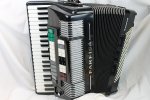
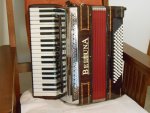
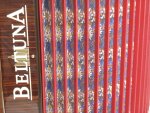
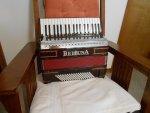
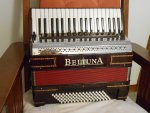
Closely following the Cordovox I played in my Embers combo, I purchased a Farfisa Transivox Piano Accordion. (A web photo is attached. My own photos are prints and I have never converted them to an electronic format). One other adjustment I made when I got this one was to replace the 860 Leslie with two smaller speakers. Those 860s were most unwieldy to handle/transport. The Farfisa was my mainstay for as long as the Embers played in Chicago.
Life intervention happened in 1969 with the military “invite” to join their ranks. The Embers cooled almost immediately. It was rewarding, however, that during the first months of military service, my folks let me know that requests for the Embers to perform continued coming in. My brother, our guitarist, joined a college folk-rock group and did a lot of coffee house gigs. He enjoyed that. After I completed the service route, I played solo gigs with the Farfisa, backed up by my newly-acquired Hammond auto vari-64 drum system. More buttons to manage, but it was a very good percussion back up, although never really replaced Bob, the Embers drummer. Live-in-person is always better.
A health intervention considerably slowed my capability of gigging. Returning from a gig one evening, while unloading my equipment from the car, an incredible stab of back pain told me I had a real problem. I could barely crawl into the house! After medical care and testing (three straight days on my back, and no work for weeks after), the diagnosis was I pinched a nerve as seven vertebrae twisted against the nerve cord. Four went one direction, three went opposite. Eventually after recovery as best as was possible, it was more challenging to transport my musical instruments. I continued to play, but less gigging as time went on. I never stopped playing, but changes to help my weakened back had to be made.
This brought me to my fourth accordion. It felt like I was back in grade school, but it was still good. I let go of the Farfisa accordion and all electronic equipment, when I was gifted a Noble acoustic accordion by a Kansas friend who just quit playing music. The “switch” was vast to my hearing after the great sounds generated by the Cordovox and Farfisa. But the beat went on.
The last of my lifetime accordions is my current Beltuna Tyrolean. Continuing with the acoustic sounds, this model has the deepest, most beautiful bass I’ve ever heard. For a person who still plays some jazz accordion, it suits me. I’m yet back-challenged, but continue to adjust my backstrap, and am always most careful when taking in and out of its case. I am most fortunate to be able to play. This is my 67th year since I started.
Final comments on the Beltuna purchase. I found this model next door to Missouri at a small accordion service shop in nearby Kansas. The owner is an elderly fellow (even older than I am!), a very accomplished accordionist and skilled in tuning and servicing accordions. The Beltuna was the only one he had on his display shelves. So I never shopped further because of the smaller size and weight, and especially the incredible sounds it produced. The other change is how colorful it is. I love silver on black, so this was a huge eye acceptance in my thinking. However, many folk-Slavic accordions carry this appearance, and I like those. So I could say it is not the perfect choice, but very close. I believe this fifth one will be my final one.
Thanks to all for letting me share my life-time accordions with you. Enjoy the pictures of my Beltuna that I’ve taken since I joined the conversation. Have a great day!





